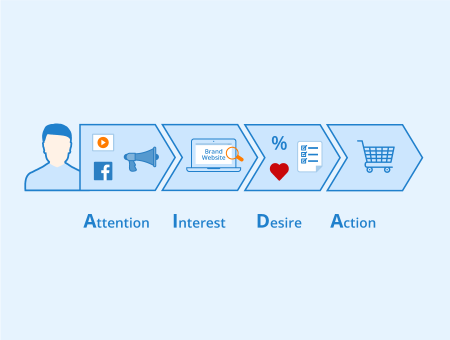Definition

AIDA is a principle used in advertising and marketing which divides the customer journey into four steps, from the initial contact with a company to the final action. These four stages are called “Attention”, “Interest”, “Desire”, and “Action” and build on each other. The model was developed at the end of the 19th century by the American advertising expert Elmo Lewis. His formula has been extended several times since then, but its basic form is also still used in marketing.
The four stages of AIDA
Attention
According to the AIDA model, every customer contact starts with attention. Attention is typically created through advertising, often in the form of eye-catching campaigns. In phase A of the AIDA model, it is assumed that you have to win the attention of potential new customers who don’t know your company. The marketing formula can be used to get attention for your brand, as well as for new products, or services.
Interest
When you have the customers’ attention, the interest stage begins. The aim here is to strengthen the interest in your offers through advertising. This can be done, for example, by clearly describing a product or with the help of slogans. At this point, customers should have your offer’s name in their minds.
Desire
The third stage of the AIDA formula is all about desire. Your marketing strategies should address customers on a rational or emotional level so that they develop a need for your product or service. For example, customers can be convinced on a rational level through messages about quality or price advantages. Emotional methods to arouse desire often focus on the image of an offer (“is trendy”), status-related promises (“is used by celebrities”), or safety concerns (“protects against intruders”). These rational and emotional arguments can be combined, for example through the use of brand ambassadors or influencers.

Screenshot of puma.com as an example of how influencer marketing can be used to create desire
Action
Once the customer has been guided all the way to the purchase decision, the final stage of the AIDA formula follows with concrete action. In theory, AIDA is only applied successfully when a purchase actually happens. In online business, this fourth stage is often initiated by what is known as a “call to action”. This is where the influence of advertising ends and your focus should be on making the technical buying process as straightforward as possible. An above-average number of cancellations in the ordering process indicates that AIDA fails in the end due to reasons such as complicated user navigation.
In the context of advertising, the four stages of AIDA usually overlap. For example, attention and interest are closely linked and may be addressed in the same ad, or even the same sentence/paragraph. Still, it is important to clearly define the four stages of the AIDA formula in order to successfully work with this model and enable accurate analysis.
AIDA-S and AIDCAS – Enhancements to the AIDA formula
The most important enhancement to the original AIDA formula is the addition of satisfaction as a fifth stage. By measuring customer satisfaction, the model is altered to include goals like subsequent purchases and referrals. AIDA-S is expressed in methods such as customer ratings, newsletters, or follow-up surveys by phone.
AIDCAS adds another stage between step three and four of the classic formula. This stage is called “Conviction”. When attention, interest, and desire are already aroused, you have to address customers once again in order to convince them completely. A frequently used advertising strategy for this is comparing your offer with that of your competitors.
AIDA in Content Marketing and Copywriting
Today, AIDA is most commonly used in copywriting and content marketing. In these marketing disciplines, AIDA is not just a formula but a storyteller’s guide, catching a reader’s attention and then guiding them towards taking action.
In the context of content marketing, AIDA facilitates the creation of content that engages the audience at every stage of their journey. Copywriters use AIDA to craft messages that first grab attention with headlines, then pique interest in the intro and then stoke desire by emphasizing the unique benefits of a product or service. Finally, a compelling call to action is used to get readers to perform a certain action.
By addressing the customer’s needs and interests at each stage and focusing content marketing efforts around these stages, AIDA helps in building a relationship rather than just pushing for a sale, while also making content marketing efforts more efficient.

An example of AIDA in action on the HubSpot blog, demonstrating all four phases of the AIDA model from top to bottom.
AIDA model example
For this example, imagine a small software company called SoftSolutions, which provides project management tools for freelancers:
- Attention: The initial step involves capturing attention through SEO-optimized content. SoftSolutions could develop a series of informative articles addressing common project management issues, ensuring the use of relevant keywords such as “how to manage freelance projects.” The company might also engage in search engine marketing, bidding on these keywords to appear prominently in search results to gain as much attention as possible.
- Interest: To sustain interest, SoftSolutions might leverage social media platforms to run (retargeting) ads for their SaaS solution based on who views their website content, complemented by educational infographics that succinctly outline the software’s benefits. Additionally, they would mention and link to their software in the SEO content produced in the previous step, trying to move their reader’s attention towards interest in their product.
- Desire: In the desire phase, SoftSolutions would aim to showcase the value of their software through client testimonials and detailed case studies, which would be shared across their digital platforms and sales pages. Email marketing campaigns could be employed to deliver tailored content to their subscribers, highlighting the software’s features and the tangible benefits for freelancers.
- Action: The final phase focuses on inciting action. SoftSolutions would optimize their website’s conversion paths, ensuring that calls to action such as “Start Your Free Trial” are prominently displayed and that landing pages are both SEO-friendly and user-centric, facilitating a seamless conversion experience.
Criticism of the AIDA model
The main criticism of AIDA is that customers’ purchasing decisions and the process leading there are not the same as they were more than 120 years ago when the model was introduced. For example, a customer who becomes aware of an offer through Google Search may have already shown interest in advance depending on their search term.
In addition, the AIDA model appears limited in its suggested finality. For example, it is questionable if attention always leads to the willingness to engage in the next stages of AIDA. Other important points of criticism include customer loyalty being ignored by the original AIDA formula or the significantly increased possibilities for comparing offers. However, these were taken into account by AIDA-S and AIDCAS respectively.
Overall, the AIDA model has become a standard in advertising and marketing and its consistent application can help with winning new customers and launching new offers.
In summary: AIDA formula FAQs
What is the AIDA formula?
The acronym AIDA stands for a marketing tool that is used to divide customer journeys into four steps.
What are the different stages of the AIDA formula?
The four stages of AIDA are:
- Attention
- Interest
- Desire
- Action
What are AIDA-S and AIDCAS?
AIDA-S and AIDCAS are advancements of the AIDA formula. Both of them add another stage to the AIDA model.
What are the weaknesses of the AIDA model?
The original model is more than 120 years old and ignores important points like customer loyalty or new possibilities offered by search engines.
Related links
Similar articles
